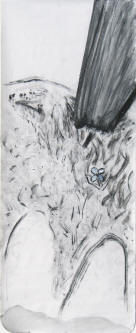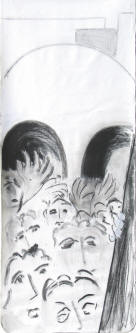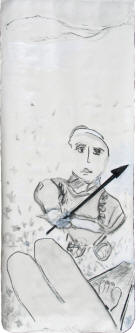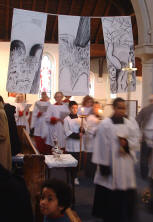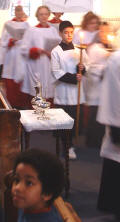| XXI Stations of the Cross — |
|
"— as seen from the eyes of Jesus" at St Andrew's, Fulham Fields London 2006 for the 2017 Gloucester set click here all are done in charcoal on canvas 210 x 80 cms
images | > installation | > texts
I — Christ is condemned to death. | II — He receives the Cross. | III — He stumbles for the first time. | IV — He meets His Mother. | V — Simon takes the weight of the Cross. | VI — Veronica wipes his brow. | VII — He receives the Crown of Thorns.
VIII — He stumbles again. | IX — The women weep. | X — He stumbles a third time. | XI — His garments are stripped from Him. | XII — The Flagellation. | XIII — He is nailed to the Cross. | XIV — He is offered vinegar.
XV — The soldier pierces His side. | XVI — He dies. | XVII — His body is taken down. | XVIII — The Resurrection: in the Garden... | XIX — The Resurrection: supper at Emmaus... | XX — The Resurrection: breaking fast by the sea... | XXI — The Resurrection: Thomas doubts... in situ i) on display ii) in worship: Mass & Communion iii) in worship: Evensong I) on display I am very grateful to Peter Strefford for his photographs; the images in this section are my montages based on his stills. Stations of the Cross were arrayed in an anti-clockwise direction starting from the north side of the altar at st Andrew's... Above we see the first six Stations, from right to left Pilate, the Carpenter, the first fall, His Mother, Simon and Veronica. Below, the following twelve Stations (right to left), along the south aisle.
Below, the final three Resurrection images, hanging across the altar. in worship: I) Holy Communion Photographs taken by the artist at Mass celebrated on Sunday, 25th February, 2007 The Entrance Procession makes its way under the Stations...
three Stations of the Resurrection above him...
In the midst of his congregation, Father Martin reads from the Gospels...
at the Sacrament of Holy Communion. in worship: II) Evensong
The Choir sings beneath the Stations of the Resurrection. Jonathon Brown and the "Stations of the Cross" an introduction by Herbert Glenn When a request for a large “Jazz Curtain” as a backdrop, for a festival in France, took on a life of its own, it led Jonathon to produce a shimmering, benign and almost classical vision of the Crucifixion, and he followed this with a rumbustuous version of the drunken Noah. From these first unexpected skirmishes came a taste for what could be called narrative painting, even if Jonathon did not find exactly which great theme to tackle next. He went back to Tuscany to visit the work of the Italian religious artists he reveres — the Pisano family of sculptors and Donatello, Fra Angelico and Piero della Francesca — but it was only last autumn, visiting his old friend Father Martin Eastwood, that their conversation pointed him at last to the apt theme that has fired his imagination. Namely, to do a set of Stations of the Cross. However, just as Jonathon had been unable to envisage a landscape except from behind the steering wheel of his trusty old car — the “RoadMovies” often include in the field of vision the dashboard or a rear-view mirror — he found he could only envisage this journey of Our Lord as if through His eyes, carrying the Cross, the rough wood inches from His beard, face to face with His many tormentors and His few friends, looking across in final exhaustion from that appalling angle upon the skull-laden Golgotha. The result is an unprecedented sequence of images of uniquely physical directness yet with an inner and intimate quality that we cannot avoid. Some Words by the artist extracted from an interview with Herbert Glenn, 26th January 2006
I remember that at Nursery School, one punishment was to be ‘sent to the corner’. There you stood, in cramped shame, your back to the continuing class, with just the corner of the plain walls to look at. Aged 5, I suppose, I loved it: on the grubby wall as I gazed at it, I invented landscapes mapped in the cracking tatty paint, where the river was, the railway, the post office and the coppice, whatever. Shame and discomfort evaporated as I watched. Often in distress, such as bereavement, people find their greatest capacity for gentility and generosity. But I can never have expected that I would imagine Jesus noting the fact that the carpenter who hands me my cross has a work-worn broken finger-nail. Stations of the Cross forms a project inspired by conversations with Father Martin Eastwood of the Church of St Andrew's Fulham Fields in London W14. The Church has a set of bas-reliefs of the stations, dating from perhaps the 1920s, and Father Martin's idea has been to continue this theme in new work that may bring fresh thought to the sequence. Oddly it is not a sequence that has received such distinguished treatment in the art of our civilisation — as has, for instance, the full Life of Christ seen for us by Duccio or Fra Angelico or the Passion brought to us by Donatello or Bach. In the recent century, however, thin enough in terms of religious art, one singular highlight comes with the Stations of the Cross at the Chapel designed and embellished by Matisse, in Vence, not an hour from my home. The idea had something going for it. We strolled and we talked. I was surprised but also troubled by my immediate enthusiasm for the project. Yet I knew immediately the only way in which I could envisage this story; timidly, the day after our long and varied discussion and debate, I asked Father Martin what he thought of the idea — that the Stations be 'seen' in the pictures as if through the eyes of Jesus, rather than being presented as a sequence of views of Him. If I achieve anything in these pictures it will be no little thanks to Father Martin's instinctive, immediate enthusiasm for this idea, mingled as it may well have been with a sense of 'surprised but also troubled' on his part too. Possibly my worry had been that few have the right, so to speak, to see through the eyes of another, let alone through those of one they have not met, let alone those of Jesus. Yet the theoretical antidote to that worry came simply enough, in that if suffering is not somehow immediate, its message is diluted. And somewhere an image of Jesus as a bearded chap over there with his timber, fixes things in a possibly unhelpful manner, both too remote and too specific, while I hope an image that places us in his perspective may unearth useful thoughts and empathy from our regimented visions as ‘third party’. When you think about it, most pictures of something are ‘from the seer’s eyes’; of course they are. But we don’t think about it. We seldom notice how much of ourselves we see when we see out upon the world. If there’s a finger across the lens we think the photograph is spoilt and we take another. Yet Rodin’s Thinker would be seeing his fist too, however much he may also contemplate the seething awfulness of Hell below him or — as wags have it — wonder where he lost the house keys. Much of my inspiration always comes from music and it may or may not be helpful to mention here that Wagner’s Parsifal, curiously often associated with Christian celebration of Easter, is for me one of the most telling meditations on the crisis between merely observing something and fully experiencing it. The idea of incorporating parts of the seer’s self in an image, as it were, is not new in my work. My so-called RoadMovie pictures of landscape seen as if on the move, in a car, often include the rear-view mirror, part of the dashboard or steering wheel, for instance, to place you more firmly as the driver. (My love of music is a love of an art of passage and time.) And it is familiar by implication to those who have an acquaintance with Chinese scroll painting. Indeed, after completing these pictures and finally deciding to keep to the supposedly monochrome medium of charcoal, I realised in retrospect how secretly important had been my memory of a Qing dynasty scroll I saw in Paris in June 2004, Pines and Thuyas in Spring, by Zhu Da (1624-1705), itself a copy of a piece by Shen Zhou done perhaps fifty years earlier. This scroll is about 14 yards long, all in black ink and washes on paper. Crassly called a ‘panorama’ in the catalogue, it tells of an uphill walk past some trees on a rocky outcrop, towards a shaded and restful view out to a further mountain ridge or pass; the gnarled brushstrokes tell of the trees but feet away, and stabbing strokes of the pricklesome pines in your hair. There at the summit you too rest, to pick needles from your head and enjoy the sun through the softer leaves that reward your climb. All in washes of gray. These visual or technical ancestries are one thing. Many other themes started to take on new life, however, once the idea had taken hold of me. For instance, I realise how distant we are from so many depictions; we aren’t really quite there. When Jesus takes the Cross I want us to know He takes in His hands, inches from His eyes, a raw, splintery rifle-sight of railway sleepers few of us could even carry to the car, let alone uphill to our death. The wood is against His cheek an inch or two away and I want it inches from yours. His falls bring him to earth (as we say, meaning something similar) where there is dust and pebbles, some grass in the dirt and, to bless our fixed and tiny attention, some flowers, small, glorious, cruciform tragedies of fragility and magnificence — and some creepy-crawlies too, of course, trudging their quotidian quotas unawares, like the immortal ploughman in the Breughel painting of The Fall of Icarus... Then come the faces, Pilate in his exasperation, the Carpenter in his trade, His Mother's in — in agonised wonder? in some version of pride and terror? Then Simon, Veronica, and so on. And as I worked the pictures out in preliminary sketches I found that the more we are with Him, or as Him, in a marvellous way we are also all the more with us, as we look at the others who join Him. By some strange chemistry, we see ourselves better in the onlookers and perpetrators than we would, I feel, in a conventional view of the chap over there with his cross. We become unavoidable, as does the plight of Jesus. This story is, as I started to think, a story ever more resonant in seeing, in sight, in close sight and drastic perspectives, how we see and how we are seen. And conceits of sight are useless, unless — we see them... é return to top é
|







